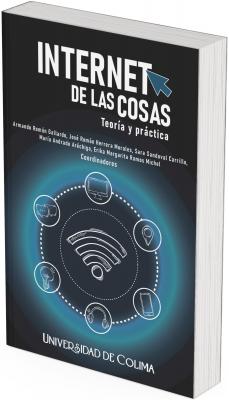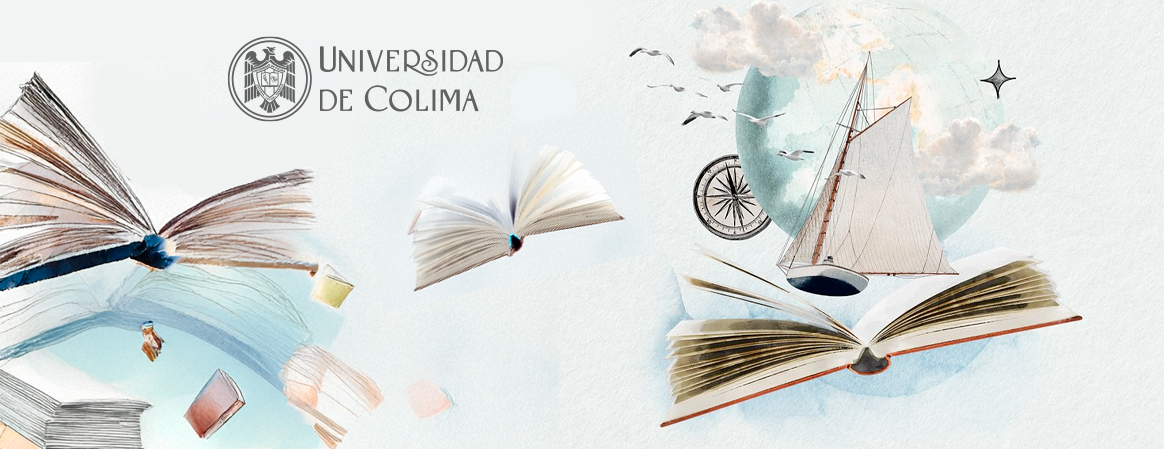Internet of Things: Theory and Practice
Keywords:
IoT, Internet, hardware, software, platforms, devices, informationSynopsis
This book addresses aspects related to the hardware and software that make the Internet of Things possible, from its components, connectivity, protocol,platforms, and automatic learning which enhance it, including practical exercises that will let the reader carry out implementations of IoT.
While it’s true that it’s been just over 20 years that the term Internet of Things was coined, nowadays, this technology is present in many daily activities and in fields as diverse as school, home, industry, and transportation, among others. The possibility of connecting a large ammount of devices to each other, makes it possible to obtain information of relatively everything that surrounds us. If, along with this, you can also count on enough storage and processing capacity, as well as analitical techniques and convenient statistics; it’s easy to understand how It’s possible to enhance health care, improve the chains of supply and protection, protect the environment, develop autonomous vehicles, robots that help with household chores, or traffic lights that avoid traffic jams. However, the advancement in this technology also imposes challenges, among them information security, connectivity and speed limitations, standardization, or sustainability.
Downloads
References
Ashton, K. (2015). How to fly a horse: the secret history of creation, invention, and discovery. Doubleday.
AVSystem. (2021). What is Internet of things (IoT)? Everything you need to know. https://www.avsystem.com/blog/what-is-internet-of-things-explanation/
Biswas, A. y Giaffreda, R. (2014). IoT and cloud convergence: opportunities and challenges. En 2014 IEEE World Forum on Internet of Things (WF-IoT) (pp. 375-376). https://doi.org/10.1109/WF-IoT.2014.6803194
Chui, M., Loffer, M. y Roberts, R. (2010). The Internet of things. McKinsey Quarterly 2(2), pp. 1-9.
C3.ai. (2021). Largest production deployment of AI and IoT applications. https://c3.ai/customers/enel/
Colakovic, A. y Hadzialic, M. (2018). Internet of things (IoT): a review of enabling technologies, challenges, and open research issues, computer networks. https://doi.org/10.1016/j.comnet.2018.07.017
Digi. (2021). NuMedia unveils next generation of PRSONAS digital hosts -Powered by Digi. https://www.digi.com/customer-stories/numedia-interactive-self-service-holograms
Fernández, R. (2022). El Internet de las cosas (IoT) - Datos estadísticos. Statista. https://es.statista.com/temas/6976/el-internet-de-lascosas-iot/#dossierKeyfigures
GE Digital. (2021a). Severstal reduces unscheduled maintenance delays by 20% with predix asset performance management. https://www.ge.com/digital/customers/severstal-reduces-unscheduled-maintenance-delays-20-asset-performance-management
GE Digital. (2021b). Exelon optimizes wind forecasting accuracy. https://www.ge.com/digital/customers/exelon-optimizes-wind-forecasting-accuracy#to-section-index=section-5
Geotab. (2020). Caledonian Logistics: logistics company seeks reliable driver monitoring. https://www.geotab.com/case-study/caledonian-logistics/
GOVTech. (2021). Smart nation sensor platform. https://www.tech.gov.sg/products-and-services/smart-nation-sensor-platform/
Hassanalieragh, M., Page, A., Soyata, T., Sharma, G., Aktas, M., Mateos, G., Kantarci, B. y Andrescu, S. (2015). Health monitoring and management using Internet of things (IoT) sensing with cloudbased processing: opportunities and challenges. En 2015 IEEE International Conference on Services Computing (pp. 285-292). https://doi.org/10.1109/SCC.2015.47
Javaid, N., Sher, A., Nasir, H. y Guizani, N. (2018). Intelligence in IoT-based 5G networks: opportunities and challenges. IEEE Communications Magazine, 56(10), pp. 94-100. https://doi.org/10.1109/MCOM.2018.1800036
Langley, D., van Doorn, J., Ng, I., Stieglitz, S., Lazovik, A. y Boonstra, A. (2021). The Internet of everything: smart things and their impact on business models. Journal of Business Research, 122, pp. 853-863. https://doi.org/10.1016/j.jbusres.2019.12.035
Lasse Lueth, K. (2020). Top 10 IoT applications in 2020. IOT Analytics Market Insights for the Internet of Things. https://iot-analytics.com/top-10-iot-applications-in-2020/
LUCI Association. (2021). Smart lighting for Amsterdam's Hoekenrodeplein square. https://www.luciassociation.org/smart-lighting-for-amsterdams-hoekenrodeplein-square/
Ramachandran, G. y Krishnamachari, B. (2018). Blockchain for the IoT: opportunities and challenges. Computer science, distributed, parallel, and cluster computing. Cornell University.
RetailNext. (2021). Resources. Consultado el 16/11/2021 de https://retailnext.net/resources
Samsara. (2021). Case study KWRL Transportation Co-op. The leader in Industrial IoT. https://corpweb-static.s3-us-west-2.amazonaws.com/pdf/docs/Samsara-Case-Study-KWRL.pdf
Telia. (2020). Fuel Savings and better driving habits for onnibus. https://business.teliacompany.com/blog/Fuel-savings-and-better-driving-habits-for-OnnibusApellidos
Veneri, G. y Capasso, A. (2018). Hands-on Industrial Internet of things. Editorial Packt Publishing.
Wilson, M. (2021). Howden creates mixed reality solutions to enhance customer experience. Leveraged Vuforia Studio to improve service and reduce customer downtime: case studies. Ptc.com https://www.ptc.com/en/case-studies/howden-mixed-reality
ABI Research. (2017). System integrators quickly becoming the IoT gatekeepers. Consultado el 7 de enero de 2022 de https://www.abiresearch.com/press/system-integrators-quickly-becoming-iot-gatekeeper/
AVSystem.com. (2021). IoT ecosystem: 4 key elements. https://www.avsystem.com/blog/iot-ecosystem/
Bello, O., Zeadally, S. y Badra, M. (2017). Network layer inter-operation of Device-to-Device communication technologies in Internet of Things (IoT). Ad Hoc Networks, 57. pp 52-62. https://doi.org/10.1016/j.adhoc.2016.06.010
Lee, I. (2019). The Internet of things for enterprises: an ecosystem, architecture, and IoT service business model. Internet of Things, 7. https://doi.org/10.1016/j.iot.2019.100078
Leminen, S., Rajahonka, M., Westerlund, M. y Wendelin, R. (2018). The future of the Internet of things: towards heterarchical ecosystems and service business models. Journal of Business & Industrial Marketing, 33(6). https://doi.org/10.1108/JBIM-10-2015-0206
Mazhelis, O., Luoma, E. y Warma, H. (2012). Defining an Internet-of-Things Ecosystem. En S. Andreev, S. Balandin e Y. Koucheryavy (Eds.), Internet of things, smart spaces, and next generation networking. ruSMART 2012, NEW2AN 2012. Lecture Notes in Computer Science. Vol. 7469 (pp. 1-14). Springer. https://doi.org/10.1007/978-3-642-32686-8_1
Microsoft. (2022). Azure IoT. La plataforma de Internet de las cosas de Microsoft. https://azure.microsoft.com/es-mx/overview/iot/
Bijoy, P. (2020). IoT Architecture - Bricks of IoT Ecosystem. Qmansys Infosolutions. https://www.qmansys.com/iot-architecture-bricks-of-iot-ecosystem/
Sinclair, B. (2016). IoT ecosystems versus IoT platforms. IoT-Inc.com https://www.iot-inc.com/iot-ecosystems-versus-iot-platforms-article/
Singh, K. J. y Kapoor, D.S. (2017). Create your own Internet of things: a survey of IoT platforms. IEEE Consumer Electronics Magazine, 6(2), pp. 57-68. https://doi.org/10.1109/MCE.2016.2640718
Sinha, RS., Wei, Y. y Hwang, S. H. (2017). A survey on LPWA technology: LoRa and NB-IoT. ICT Express, 3(1), pp. 14-21. https://doi.org/10.1016/j.icte.2017.03.004
Tarkoma, S. y Katasonov, A. (2011). Internet of things strategic research agenda (IoT-SRA). Finnish Strategic Centre for Science, Technology, and Innovation: for Information and Communications (ICT) Services, Businesses, and Technologies. http://www.internetofthings.fi/extras/internet-of-things-strategic-research-agenda.pdf
Thalesgroup.com (2021). The IoT ecosystem in 2021: components, industry alliances and legal environments. https://www.thalesgroup.com/en/markets/digital-identity-and-security/iot/inspired/iot-building-blocks
Westerlund, M., Leminen, S. y Rajahonka, M. (2014). Designing business models for the Internet of things. Technology Innovation Management Review, 4(7) pp. 5-14. https://doi.org/10.22215/timreview/807
Yildhiz, M. (2020). Introduction to IoT Ecosystem. A technical, architectural and solution design overview. Portal Medium. https://medium.com/technology-hits/introduction-to-iot-ecosystem-25b359c8cf23
Abdelouhahid, R. A., Debauche, O., Mahmoudi, S., Marzak, A., Manneback, P. y Lebeau, F. (2020). Open Phytotron: a new IoT device for home gardening. En 2020 5th International Conference on Cloud Computing and Artificial Intelligence: technologies and applications (CloudTech), pp. 1-8. https://doi.org/10.1109/CloudTech49835.2020.9365892
Ábrego Preza, E. S., Araujo Ayala, O. D., Góchez Zelaya, E. A. y Navarro Masferrer, C. E. (2018). Fabricación de PLC utilizando microcontroladores para uso didáctico con características industriales. http://redicces.org.sv/jspui/handle/10972/3392.
Avsystem. (2020). Top sensor types used in IoT. https://www.avsystem.com/blog/iot-sensors-iot-actuators/
Bengochea-Guevara, J. M., Espinosa-Bustillo, M. Á., Romano, G., Martín-Martínez, F. M., Muñoz-Frías, J. D. y Rodríguez Pecharromán, R. (2020). Microprocesadores. http://hdl.handle.net/11531/70549
Debauche, O., Abdelouahid, R.A., Mahmoudi, S., Moussaoui, Y., Marzak, A. y Manneback, P. (2020). RevoCampus: a distributed open source and low-cost smart campus. En 2020 3rd International Conference on Advanced Communication Technologies and Networking (CommNet), pp. 1-10. https://doi.org/10.1109/CommNet49926.2020.9199640
El-Abd, M. A (2017). Review of embedded systems education in the Arduino age: lessons learned and future directions. International Journal of Engineering Pedagogy, 7(2), pp. 79-93. https://doi.org/10.3991/ijep.v7i2.6845
Gómez-Guzmán, E., Mejía-Gallardo, JE., Ramírez-Guerra, LD., Cruz-Yépez, R. e Ibarra-Manzano, OG. (2021). Desarrollo de aplicaciones basadas en microcontroladores orientadas al IoT. Revista digital Jóvenes en la Ciencia, 10. https://www.jovenesenlaciencia.ugto.mx/index.php/jovenesenlaciencia/article/view/3349
González García, C., Meana-Llorián, D., Pelayo García-Bustelo, B. y Cueva Lovelle, J. (2017). A review about Smart Objects, Sensors, and Actuators. International Journal of Interactive Multimedia and Artificial Intelligence, 4, pp 7-10. https://doi.org/10.9781/ijimai.2017.431
Ha, N., Xu, K., Ren, G., Mitchell, A. y Ou, J. Z. (2020). Machine learningenabled smart sensor systems. Advanced Intelligent Systems, 2(9), 2000063. https://doi.org/10.1002/aisy.202000063
Hunkeler, U., Truong, H. L. y Stanford-Clark, A. (2008). MQTT-S-A publish/ subscribe protocol for Wireless Sensor Networks. 2008 3rd International Conference on Communication Systems Software and Middlewareand Workshops (COMSWARE'08), pp. 791-798. https://doi.org/10.1109/COMSWA.2008.4554519
Hurtuk, J., Chovanec, M. y Adam, N. (2017) The Arduino platform connected to education process. En 2017 IEEE 21st International Conference on Intelligent Engineering Systems (INES), pp. 000071-000076. https://doi.org/10.1109/INES.2017.8118531
IoTConsulting.tech. (2019, 6 de diciembre). Cómo elegir un microcontrolador para IoT. https://iotconsulting.tech/como-elegir-un-microcontrolador-para-iot/
Lee, E. (2020). A meta-analysis of the effects of Arduino-based education in korean primary and secondary schools in engineering education. European Journal of Educational Research, 9(4), pp. 1503-1512. https://doi.org/10.12973/eu-jer.9.4.1503
María, F. y Daniel, J. (2018). Microprocesadores. Madakam, S., Ramaswamy, R. y Tripathi, S. (2015) Internet of Things (IoT): a literature review. Journal of Computer and Communications, 3(3), pp. 164-173. https://doi.org/10.4236/jcc.2015.35021
Mahmood, S., Palaniappan, S., Hasan, R., Sarker, K. U., Abass, A. y Rajegowda, P. M. (2019). Raspberry PI and role of IoT in Education. En 4th MEC International Conference on Big Data and Smart City (ICBDSC), pp. 1-6. https://doi.org/10.1109/ICBDSC.2019.8645598
Meijer, G. (2008). Smart sensor systems. John Wiley & Sons. https://doi.org/10.1002/9780470866931
Ramírez, L. G. C., Jiménez, G. S. A. y Carreño, J. M. (2014). Sensores y actuadores. Grupo Editorial Patria.
Salvador, D. (2020). Sensores IoT: características y aplicaciones. Nespra Smart Devices. https://www.nespra.net/blog/sensores-iot-caracteristicas-y-aplicaciones/
Thomazini, D. y de Albuquerque, P. U. B. (2020). Sensores industriais: fundamentos e aplicações. Saraiva Educação SA.
Valdés, F. y Areny, R. P. (2007). Microcontroladores fundamentos y aplicaciones con PIC Vol. 1149. Marcombo.
Yamanoor, N. S. y Yamanoor, S. (2017). High quality, low cost education with the Raspberry Pi. En 2017 IEEE Global Humanitarian Technology Conference (GHTC), 2017, pp. 1-5. https://doi.org/10.1109/GHTC.2017.8239274
Baraza, A. de J. C. (2019). Modelo de Implementación de Ciberseguridad para Sistemas IoT en el Marco de Redes 5G. http://repositorio.utp.edu.co/dspace/bitstream/handle/11059/12043/T005.8%20C393.pdf?sequence=1&isAllowed=y
Bluetooth SIG. (2021). Learn about Bluetooth. Bluetooth® Technology Website. https://www.bluetooth.com/learn-about-bluetooth/
Celer, V. (2020). Un truco para facilitar el reclamo de equipaje en el aeropuerto. https://www.celersms.com/baggage-claim-es.htm
Connectivity Standards Alliance. (2021). Zigbee. https://zigbeealliance.org/solution/zigbee/
Ismail, D., Rahman, M. y Saifullah, A. (2018). Low-power wide-area networks: Opportunities, challenges, and directions. En 19th International Conference on Distributed Computing and Networking (pp.1-6) https://doi.org/10.1145/3170521.3170529
Develco Products. (2021). White label products for IoT solutions. https://www.develcoproducts.com/products/
Hossain, M.I. y Markendahl, J.I. (2021). Comparison of LPWAN technologies: cost structure and scalability. Wireless Personal Communications, 121, pp. 887-903. https://doi.org/10.1007/s11277-021-08664-0
IEEE 802.11 WLAN Working Group. (2021). IEEE 802.11, The working group setting the standards for wireless LANs. https://www.ieee802.org/11/
NFC Forum. (2021). About the technology. https://nfc-forum.org/what-isnfc/about-the-technology/
Palattella, M. R., Dohler, M., Grieco, A., Rizzo, G., Torsner, J., Engel, T. y Ladid, L. (2016). Internet of things in the 5G era: enablers, architecture, and business models. IEEE Journal on Selected Areas in Communications, 34(3), pp. 510-527. https://doi.org/10.1109/JSAC.2016.2525418
Ramírez, I. (2021). Qué es Wi-Fi 6 y qué ventajas tiene con respecto a la versión anterior. Xataka.com https://www.xataka.com/basics/que-wi-fi-6-que-ventajas-tiene-respecto-a-version-anterior
Smart Hubs. (2021). Z-Wave. https://www.z-wave.com/shop-z-wavesmart-home-products
Swedberg, C. (2021). IoT, BLE enable emergency response to cardiac arrests. RFID Journal. https://www.rfidjournal.com/iot-ble-enable-emergency-response-to-cardiac-arrests
Venco Electrónica. (2020, 3 de diciembre). Qué es ZigBee, cómo funciona y características principales. https://www.vencoel.com/que-eszigbee-como-funciona-y-caracteristicas-principales/
Wi-Fi Alliance. (2021a). Wi-Fi Alliance. https://www.wi-fi.org/
Wi-Fi Alliance. (2021c). Wi-Fi Aware | Wi-Fi Alliance. https://www.wi-fi.org/discover-wi-fi/wi-fi-aware
Wi-Fi Alliance. (2021b). Wi-Fi Certified 6 | Wi-Fi Alliance. https://www.wifi.org/discover-wi-fi/wi-fi-certified-6
Zhiwei, X. y Ni, J. (2021). A study on key LPWAN technologies. Journal of Physics Conference Series 1871(1), 012011. https://doi.org/10.1088/1742-6596/1871/1/012011
Z.Wave Alliance. (2021). Learn. https://www.z-wave.com/learn
Abhimanyu, P. (2019). What is Power Line Communication (PLC) and how it works. CircuitsDigest. https://circuitdigest.com/article/what-ispower-line-communication-plc-and-how-does-it-work
Bassi, A. (2021). Introducción al Protocolo CoAP. Goto IoT. https://www.gotoiot.com/pages/articles/coap_intro/index.html
Caiza, G., Edison, M., Remache, E., Ortiz, A. y García, M. V. (2020). Comparación de AMQP y CoAP para la integración de las comunicaciones en el área de producción. Revista Iberica de Sistemas e Tecnologias de Informacao, 2020(E26), pp. 652-666. https://pure.ups.edu.ec/es/publications/comparaci%C3%B3n-de-amqp-y-coap-para-laintegraci%C3%B3n-de-las-comunicacio
Egli, P. (2015). LPWAN. Overview of emerging technologies for Low Power Wide Area Networks in Internet of things and M2M scenarios. Indigoo. http://indigoo.com/dox/itdp/12_MobileWireless/LPWAN.pdf
García, L. (2020), ¿Cuáles son las arquitecturas y componentes de una red IoT? Redes Móviles. https://redesmoviles.com/iot/arquitecturasiot/
González, A. y López, J. (2017). IoT: dispositivos, tecnologías de transporte y aplicaciones [Tesis de maestría, Universitat Oberta Catalunya]. Repositorio Institucional UOC.
Harwood, T. (2021). IoT standards and protocols. Postscapes Tech. https://www.postscapes.com/internet-of-things-protocols/
Hrasnica, H., Haidine, A., Lehnert, R. (2001). Performance comparison of reservation MAC protocols for broadband powerline communications networks. Revista Internet Performance and Control of Network Systems II, pp. 302-313. https://doi.org/10.1117/12.434326
Hussein T. M., Melike, E. (2015). Comunicaciones de redes inteligentes: oportunidades y Desafíos. En M. S. Obaidat, A. Anpalagan e I.
Woungang (Eds.), Handbook of green information and communication systems. https://doi.org/10.1016/B978-0-12-415844-3.00025-5
Internet Engineering Task Force (IETF). (2021a). CoAP (Constrained Application Protocol) over TCP, TLS, and WebSockets. IETF Drafts. https://tools.ietf.org/id/draft-ietf-core-coap-tcp-tls-11.html
Internet Engineering Task Force (IETF). (2021b). Group Communication for the Constrained Application Protocol (CoAP), Internet Engineering Task Force RFC 7390-2014. 56. IETF Drafts. https://datatracker.ietf.org/doc/html/rfc7390
Internet Engineering Task Force (IETF). (2021c). Block-Wise Transfers in the Constrained Application Protocol (CoAP), Internet Engineering Task Force RFC 7959-2016. IETF Drafts. https://datatracker.ietf.org/doc/html/rfc7959
Internet Engineering Task Force (IETF). (2021d). CoAP (Constrained Application Protocol) over TCP, TLS, and WebSockets, Internet Engineering Task Force RFC 8323-2018. IETF Drafts. https://www.rfc-editor.org/rfc/pdfrfc/rfc8323.txt.pdf
IONOS. (2019). AMQP: Conoce el Advanced Message Queuing. Digital Guide IONOS. https://www.ionos.es/digitalguide/paginas-web/desarrollo-web/advanced-message-queuing-protocol-amqp/
ISO/IEC. (2014). Information technology Advanced Message Queuing Protocol (AMQP) v1.0 specification. Suiza: ISO/IEC 19464:2014. https://www.iso.org/standard/64955.html
Jaffey, T. (2014). MQTT and CoAP, IoT Protocols. Eclipse Foundation. https://www.eclipse.org/community/eclipse_newsletter/2014/february/article2.php
Kowalewski, O. (2018). IoT: Evaluación de protocolos limitados de nivel de aplicación para Internet de las cosas [Tesis de Maestría, Universidad Carlos III de Madrid]. Repositorio Institucional UC3M.
Lora. (2015). LoRaWan What is it? Lora-Alliance. https://lora-alliance.org/wp-content/uploads/2020/11/what-is-lorawan.pdf
López, G., Matanza, J., De la Vega, D., Castro, M., Arrinda, A Moreno, J. y Sendin, A. (2019). The role of PowerLine Communications in the smart grid revisited: applications, challenges, and research initiative. Revista IEEE Access, 99, pp. 117346-117368. https://doi.org/10.1109/ACCESS.2019.2928391
Microsoft. (2021). Protocolos y tecnologías de IoT. Azure. https://azure.microsoft.com/es-mx/overview/internet-of-things-iot/iot-technology-protocols/
Moes, T. (2020). ¿Qué es LTE? Diferencias entre LTE y 4G. Software Labs.https://softwarelab.org/es/lte-4g/
OASIS. (2021). OASIS Advanced Message Queuing Protocol (AMQP) Version 1.0. OASIS Open. http://docs.oasis-open.org/amqp/core/v1.0/os/amqp-core-complete-v1.0-os.pdf
Pajuelo, R., González, R., Hidalgo, E. (2021). Estudio de la arquitectura DDS y diseño de una solución aplicada sobre arquitectura genérica de vehículos. (Trabajo Fin de grado inédito). Universidad de Sevilla.
Pardal-Garcés, P. (2017) Redes de área extensa para aplicaciones IoT: modelado de comunicaciones Sigfox (Tesis de máster, Universidad Politécnica de Valencia). https://riunet.upv.es/handle/10251/86052
D'Alessandro, S. y Tonello, A. (2014). Relaying protocols for In-Home PLC. En En L. Torsten, A. Schwager, P. Pagani y D. Schneider (Eds.), MIMO Power Line Communications (pp. 553-572). CRC Press. https://doi.org/10.1201/b16540
Tameem, H. (2021). Overview of the future Internet architecture projects and protocols and applications. [Tesis de grado, Nanjing University of Science and Technology] http://dx.doi.org/10.6084/m9.figshare.14938434.v1
ZigBee. (2021). IEEE 802.15 Working group for Wireless Specialty Networks (WSN). IEEE: 802.15. https://www.ieee802.org/15/
ZigBee-2 (2021). ZigBee Specification 05347r17. CSA Alliance. https://www.zigbee.org.
Asemani, M., Abdollahei, F. y Jabbari, F. (2019). Understanding IoT platforms: towards a comprehensive definition and main characteristic description. En 2019 5th International Conference on Web Research (ICWR). IEEE, 2019 (pp. 172-177). https://doi.org/10.1109/ICWR.2019.8765259
Janson, C. (2021). Top 5 IoT development Platforms in 2021. IoTforAll.com. https://www.iotforall.com/top-5-iot-development-platforms-in-2021
G2.com. (2020). The top 6 IoT platforms. https://www.g2.com/categories/iot-platforms?tab=highest_rated
Gartner. (2021). Industrial IoT Platforms reviews and ratings. https://www.gartner.com/reviews/market/industrial-iot-platforms
Gartner. (2021, 18 de octubre). Magic Quadrant for Industrial IoT Platforms. https://www.gartner.com/doc/reprints?id=1-27IESWUW&ct=210922&st=sb
Markets and Markets (2020). IoT cloud platform market by offering (platform and service), deployment mode (public cloud, private cloud and hybrid), organization size, application area (building and home automation and connected healthcare), and region - global forecast to 2025. Market Research Report TC 4609. https://www.marketsandmarkets.com/Market-Reports/iot-cloud-platform-market-195182.html
Microsoft. (2021, 25 de octubre). Microsoft named a Leader in the 2021 Gartner ® Magic Quadrant™ for Industrial IoT Platforms. https://azure.microsoft.com/en-us/blog/microsoft-named-a-leader-in-the-2021-gartner-magic-quadrant-for-industrial-iot-platforms/
PTC. (2021). PTC has been recognized as a Leader among IIoT platform providers in 2021 Gartner® Magic Quadrant™ for Industrial IoT Platforms. https://www.ptc.com/en/resources/iiot/white-paper/gartner-mq-for-iiot
Sakovich, N. (2021). 10 best IoT platforms for 2021. SaM-Solutions.com. https://www.sam-solutions.com/blog/top-iot-platforms/
Shten, O. (2020). 10 best IoT platforms for 2021. Portal Dzone. https://dzone.com/articles/10-best-iot-platforms-for-2021
Silva, J.d.C., Rodrigues, J.J.P.C., Al-Muhtadi, J., Rabêlo, R.A.L. y Furtado, V. (2019). Management platforms and protocols for Internet of things: a survey. Sensors, (19)3, p. 676. https://doi.org/10.3390/s19030676
SoftwareTestingHelp.com. (2021). 10 best IoT platforms to watch out in 2021. https://www.softwaretestinghelp.com/best-iot-platforms/
Statista (2019). Number of publicly known Internet of things (IoT) platforms worldwide from 2015 to 2019. https://www.statista.com/statistics/1101483/global-number-iot-platform/
ABI Research. (2021). IoT data-enabled services: value chain, companies to watch, and cloud wars. https://www.abiresearch.com/market-research/product/7778820-iot-data-enabled-services-value-chaincomp/
AWS (2021a). AWS IoT para los hogares conectados. Amazon Web Services. https://aws.amazon.com/es/iot/solutions/connected-home/
AWS (2021b). Inferencia de ML de AWS IoT Greengrass. Implementación de modelos de machine learning optimizados para ejecutarse en dispositivos AWS IoT Greengrass. https://aws.amazon.com/es/greengrass/ml/
BigData (2021). Descubriendo el potencial de IoT con inteligencia artificial y aprendizaje automático. Maching Learning. https://topbigdata.es/descubriendo-el-potencial-de-iot-con-inteligencia-artificial-y-aprendizaje-automatico/
Bisong, E. (2019). Building machine learning and deep learning models on Google Cloud Platform. A comprehensive guide for beginners. Apress Berkeley. https://doi.org/10.1007/978-1-4842-4470-8
Brianza, A. (2019). Audiovisión e Inteligencia Artificial. En A. Gómez, A. León Grisales, O. E. Tamayo y S. H. Sierra (Eds.), Diseño y Creación (Primera ed., pp. 177-181). Universidad de Caldas.
Carmona Suárez, E. J. y Fernández Galán, S. (2020). Fundamentos de computación evolutiva. Marcombo.
Columbus, L. (2020, 12 de octubre). 10 insights from Microsoft's latest IoT signals report. Forbes.com. https://www.forbes.com/sites/louiscolumbus/2020/10/12/10-insights-from-microsofts-latest-iot-signals-report/?sh=510017745fa5
D'Arc, T. (2020). Qué es la Inteligencia Artificial: 8 ejemplos en tu vida diaria. https://www.smarthint.co/es/o-que-e-inteligencia-artificialexemplos/?utm_source=blog&utm_medium=post&utm_campaign=buscainteligente
Díaz-Ramírez, J. (2021). Aprendizaje automático y aprendizaje profundo. Ingeniare. Revista chilena de ingeniería, 29(2). https://doi.org/10.4067/S0718-33052021000200180
Dick, S. (2019). Artificial Intelligence. Harvard Data Science Review. https://doi.org/10.1162/99608f92.92fe150c
Ghosh, I. (2020). AIoT: When artificial intelligence meets the Internet of things. https://www.visualcapitalist.com/aiot-when-ai-meets-iottechnology/
González García, C., Núñez-Valdez, E. R., García-Díaz, V., Pelayo G-Bustelo, B. C. y Cueva Lovelle, J. M. (2018). A review of artificial intelligence in the Internet of things. International Journal of Interactive Multimedia and Artificial Intelligence, 5(4), pp. 9-20. https://doi.org/10.9781/ijimai.2018.03.004
Greengard, S. (2021). The Internet of Things. The MIT Press. https://doi.org/10.7551/mitpress/13937.001.0001
Gutiérrez Pulido, J. R., Ramos Michel, E. M. y Acosta Díaz, R. (2018). Inteligencia artificial y aprendizaje máquina: aplicaciones y tendencias. En A. Román Gallardo, S. Sandoval Carrillo, M. E. Cabello Espinosa y J. R. Herrera Moralesy (Eds.), Tecnologías disruptivas de información. Universidad de Colima. http://ww.ucol.mx/content/publicacionesenlinea/adjuntos/Tecnologias-disruptivas-deinformacion_465.pdf
Harris, D. (2022). Artificial Intelligence. What is Artificial Intelligence? How does AI work? https://builtin.com/artificial-intelligence
Li, W., Chai, Y., Khan, F., Jan, S. U., Verma, S., Menon, V. G. y Li, X. (2021). A comprehensive survey on machine learning-based Big Data analytics for IoT-Enabled smart healthcare system. Mobile Networks and Applications, 26, pp. 234-252. https://doi.org/10.1007/s11036-020-01700-6
Newell, A. y Simon, H. (1956). The Logic Theory Machine - A complex information processing system. IRE Transactions on Information Theory, (2)3, pp. 61-79. https://doi.org/10.1109/TIT.1956.1056797
Nižetić, S., Šolić, P., López-de-Ipiña González-de-Artaza, D. y Patrono, L. (2020). Internet of Things (IoT): opportunities, issues and challenges towards a smart and sustainable future. Journal of Cleaner Production, 274. https://doi.org/10.1016/j.jclepro.2020.122877
Pérez, F. A. (2019). El enfoque probabilístico en Inteligencia Artificial. (GESI, Ed.) http://www.ugr.es/~gesi/analisis-gesi-14-2019.pdf
Ponce Cruz, P. (2010). Inteligencia Artificial con aplicaciones a la Ingeniería (Primera ed.). Alfaomega.
Rouhiainen, L. (2018). Inteligencia Artificial. 101 cosas que debes saber hoy sobre nuestro futuro. Alienta.
Russell, S. y Norvig, P. (2008). Inteligencia Artificial. Un enfoque moderno (Segunda ed.). Pearson Educación.
Sarker, I. H. (2021). Machine Learning: algorithms, real-world applications and research directions. SN Computer Science, 2(160). https://doi.org/10.1007/s42979-021-00592-x
Shafique, K., Khawaja, B. A., Sabir, F., Qazi, S. y Mustaqim, M. (2020). Internet of Things (IoT) for next-generation smart systems: A review of current challenges, future trends and prospects for emerging 5G-IoT scenarios. IEEE Access, 8. https://doi.org/10.1109/ACCESS.2020.2970118
Sharma, N., Sharma, R. y Jindal, N. (2021). Machine learning and Deep learning applications - a vision. Global Transistions Proceedings, 2,24-28. https://doi.org/10.1016/j.gltp.2021.01.004
Universidad Internacional de Valencia (VIU). (2021). AIoT: un gran avance en Inteligencia Artificial y el Internet de las cosas. Universidad Internacional de Valencia. https://www.universidadviu.com/co/actualidad/nuestros-expertos/aiot-un-gran-avance-en-inteligencia-artificial-y-el-internet-de-las
Vega-Luna, J., Lagos-Acosta, M., Salgado-Guzmán, G., Cosme-Aceves, J. y Tapia-Vargas, V. (2021). Control de sensores de presencia de equipo de cómputo usando Alexa e IoT. Revista Ciencia, Ingeniería y Desarrollo Tec. Lerdo, (1)7, pp. 13-18. http://revistacid.itslerdo.edu.mx/coninci2021/CID011.pdf
Zaman, S., Alhazmi, K., Aseeri, M. A., Ahmed, M. R., Khan, R. T., Kaiser, M. S. y Mahmud, M. (2021). Security threats and Artificial Intelligence based countermeasures for Internet of Things networks: a comprehensive survey. IEEE Access, 9. https://doi.org/10.1109/ACCESS.2021.3089681
Abdullah, E., Shuhaimi, N. I., Mohamad, R., Kamaluddin, N. A., Hidayat, N. M. y Burham, N. (2021). Development of real-time energy monitoring system and data log using NodeMCU ESP 8266 and MYSQL Database. https://www.researchgate.net/publication/356509140_Development_of_Real-Time_Energy_Monitoring_System_and_Data_Log_Using_NodeMCU_ESP_8266_and_MYSQL_Database
Almenara, J. A. (2020). Proyecto fin de carrera Ingeniería de Telecomunicación. Universidad de Sevilla.
Álvarez Carulla, A. (2021). Comunicación de un módulo ESP32 con Ubidots mediante MQTT. http://hdl.handle.net/2445/181905
Boyes, H., Hallaq, B., Cunningham, J. y Watson, T. (2018). The industrial internet of things (IIoT): an analysis framework. Computers in Industry, 101, 1-12. https://doi.org/10.1016/j.compind.2018.04.015
Geek Factory. (2020). Conectar un led a tu Arduino. https://www.geekfactory.mx/tutoriales-arduino/conectar-un-led-a-tu-arduino/
Hwang, K., Lee, J. M., Jung, I. H. y Lee, D.-H. (2019). Modification of mosquitto broker for delivery of urgent MQTT message. En 2019 IEEE Eurasia Conference on IOT, Communication and Engineering (ECICE) (pp. 166-167). https://doi.org/10.1109/ECICE47484.2019.8942800
Ilham, A. (2020). Ancang bangun stasiun cuaca menggunakan dht22, bmp180, nodemcu dengan arduino ide melalui blynk server. Nusa Putra University.
Junizan, N. A., Razak, A. A., Balakrishnan, B. y Othman, W. (2019). Design and implementation of automatic room temperature controlled fan using Arduino Uno and LM35 heat sensor. International Journal of Engineering Creativity & Innovation, 1(2), pp. 8-14.
Mishra, B. y Kertesz, A. (2020). The use of MQTT in M2M and IoT systems: a survey. IEEE Access, 8, 201071-201086. https://doi.org/10.1109/ACCESS.2020.3035849
Novillo-Vicuña, J., Rojas, D. H., Olivo, B. M., Ríos, J. M. y Villavicencio, O. C. (2018). Arduino y el Internet de las cosas. Ciencias, 45(3). https://doi.org/10.17993/IngyTec.2018.45
Parihar, Y. S. (2019). Internet of things and Nodemcu. Journal of Emerging Technologies and Innovative Research, 6(6), 1085. http://dx.doi.org/10.13140/RG.2.2.34456.75525
Peña, C. (2020). Arduino IDE: Domina la programación y controla la placa. RedUsers.
Perkasa, R., Wahyuni, R., Melyanti, R. e Irawan, Y. (2021). Light control using human body temperature based on Arduino Uno and PIR (Passive Infrared Receiver) Sensor. Journal of Robotics and Control (JRC), 2(4), pp. 307-310. https://doi.org/10.18196/jrc.2497
Prasetyawan, P., Samsugi, S. y Prabowo, R. (2021). Internet of things menggunakan Firebase dan Nodemcu untuk Helm Pintar. Jurnal ELTIKOM: Jurnal Teknik Elektro, Teknologi Informasi Dan Komputer, 5(1), pp. 32-39. https://doi.org/10.31961/eltikom.v5i1.239
Naylamp mechatronics (2020). Usando ESP8266 con el IDE de Arduino. https://naylampmechatronics.com/blog/56_usando-esp8266-con-el-ide-de-arduino.html
Valderrama, J. y Brea, E. (2020). ESP8266: Un microcontrolador para el Internet de las cosas. En Jornadas de investigación. Universidad Central de Venezuela, Tech. Rep. http://www.ing.ucv.ve/jifi2018/documentos/electronica/ERT-006.pdf
Vergara, J. E. (2021). Ingenieros industriales desarrollando proyectos con tecnologías IOT y Arduino - ¿Qué se necesita, ¿cómo iniciar? Gestión Competitividad e Innovación, 9(1), pp. 1-10. https://pca.edu.co/editorial/revistas/index.php/gci/article/view/131

Downloads
Published
Series
Categories
License

This work is licensed under a Creative Commons Attribution-NonCommercial-ShareAlike 4.0 International License.







